Involuntary Conversion, Gobbledygook, and Mimicked Algorithms
Involuntary Conversion, Gobbledygook, and Mimicked Algorithms
Involuntary Conversion premiered at Los Angeles’ Freewave Festival in 1991 and was subsequently presented, among many other venues, at transmediale (then called VideoFest) in 1992 and the Whitney Biennial in 1993. Involuntary Conversion is an ironic and profoundly disturbing commentary on the strategic language of deception used by governments, particularly in the US. Despite being produced over 25 years ago, this video still speaks to today’s politics, offering some sharp insights on government manipulation and misinformation that obviously still prevail.
The Zeitgeist surrounding Finley’s work was related to the US art activism of the early 90s and their engagement in theoretical linguistics. Embedded in the Post-Reagan era and the last breath of the postmodernist paradigm, this was a moment of political numbness.
The 90s were also a decade of rapid changes in video technology and its presentation formats. Finley’s work Involuntary Conversion possesses not only relevance to both linguistics and technology, but embodies an unusual methodology—and invitation to decode wherever public information appears obscured. The result could be seen as an “interlaced” inquiry into lines of political text and lines of electronic image technology. Through her work, I will try bring language and technology into direct contact, investigating today’s technological agents of political speech.

I. Reading between the lines
Let us re-imagine the last days of the world before the internet. Everything was stationary; nothing was mobile. There was no email, just clunky fax machines. Aesthetically related to the fax, there was VHS, the crude, standard-definition video technology. Blurry memories of even blurrier video visions emerge—these were moving images, broken down in 525 vertical scan lines. The VHS technology assured that a single image was never displayed; for purposes of smoother movement, two images (or fields) were always present at once. The information was interlaced, resulting in a mask of uncertainty, what we could also call an ever-undecided image—a constant becoming and constant fading.1
Finley’s video was produced with this technology. The images of Involuntary Conversion are accompanied by a dark, menacing, monophonic synth sound. Low in pitch yet with a high timbre, like a boyish voice pretending to sound much older. The tones hover in and out with a lot of reverberation, thereby establishing permanent presence—what, in electronic ambient music, is called drone. Drone soundtracks have gradually become a cliché in artist films, evoking sobriety and the most serious and sincere intentions.
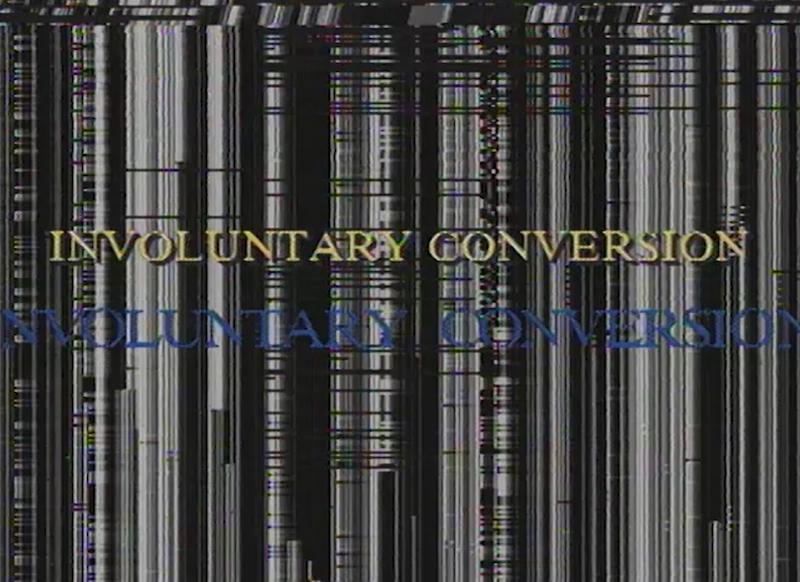
But Finley’s work also includes the other drone technology—as in the arrival of an unmanned air force. Finley’s video unconsciously foreshadows the widespread use of lethal drone weapons by depicting, as a key image throughout the video, footage of the U2 spy plane as well as the Blackhawk stealth jet.
Surveillance aligns with so many other means of deception conducted by the state apparatus, and encryption is certainly the language most enshrouded in noise and chaos. Throughout the 90s, the main signifier for “media noise” was old TV “snow,” which, in video art, was very rapidly replaced by the digital counterpart of abstract distortion. Finley uses this digital snow as a background template in some of her images, and this pixilated version of TV snow exactly prefigures the aesthetic of what has later become the essence of glitch aesthetics. It is hard to believe that—aesthetically—it has not significantly changed throughout the last 25 years.
II. Reading between the lines, again
The invention of the award-winning NewTek video toaster was announced at the Word of Commodore Expo in 1987 and released as a commercial product in December 1990. From today’s perspective, one can hardly imagine the game-changing moment of independence that this new video editing hardware and software enabled. Video artists could now output graphic images from a Commodore computer to standard NTSC video. This affordable technology helped to free up the first generation of video artist from expensive video studios, which used so-called time-based correctors to achieve the same process, but with more than ten times the hardware costs.
Therefore, video artists were now able to produce not only proper credits and subtitles but to discover a typographic dimension that could be added to the image. Parallel to this new freedom of film animation, the electronic image also gained the possibility for words and graphics to be placed on the video screen in any form the artist could desire.

Just a decade before, the only way to bring typography into the video image was the cumbersome character generator, which limited one to adding a few lines of pre-formatted text. If we were to compare this use of text to the rigidness of classical poem stanzas, then the visual act of breaking through the lines offers a parallel to the famous typographical idiosyncrasies of Stéphane Mallarmé. The nineteenth-century poet-critic, who is considered a primary inspiration for the invention of hypertext, developed conceptual and graphically unique concrete poetry, breaking up the classical stanza structure.
Jeanne Finley makes use of double-text by allowing the silent text displayed over the image to decipher the spoken word. It seems crucial that at times, for longer complicated Double Speak, the two sources coincide in absolute simultaneity. She applies text animation (crawling text lines from right to left) so the words flow across the screen at reading speed. In the end of this running text lines Finley included the actual deciphered meaning. For instance, we read and hear simultaneously the perverse Doublespeak notion of “volume-related production schedule adjustments” and immediately get the meaning: They mean factory shut downs.
III. Reading between the lines, again
Jeanne Finley’s inquiry into political speech was based on a seminal article, “Doublespeak,” and a subsequent book under same title by linguist William Lutz, in which he introduced the term in the following way:
Doublespeak is a language that pretends to communicate but really does not. It is language that makes the bad seem good, the negative appears positive, the unpleasant appear attractive, or at least tolerable. It is language that avoids or shifts responsibility; language which is at variance with its real and its purported meaning; language which conceals or prevents thought. Double speak is language which does not extend thought but limits it. […]
Basic to doublespeak is incongruity, the incongruity between what is said or left unsaid, and what really is. […] It is the incongruity between the word and the referent, between ‘seem’ and ‘be’, between the essential function of language -communication- and what doublespeak does- mislead, distort, deceive, inflate, circumvent, obfuscate.2
Lutz published his first essays on Doublespeak in the early 1980s, later establishing the journal Doublespeak Quarterly as well as serving as the chairman of a notorious “Doublespeak Award,” handed out by the National Council of the Teachers of English (NCTE). Both initiatives served as noble watchdogs of obfuscatory language in national public addresses. In 1989, Lutz finally summarized his linguistic research in a stupendous publication which hit the nerve of the time and became a best-seller. It doesn’t seem surprising that in 1991, the year Finley premiered her video, the Doublespeak award was given to a number of government speakers including Rep. Newt Gingrich and President Bush Senior, who were recognized by the award for “grossly deceptive public remarks and language with pernicious political and social consequences.”3
On the verge of being overdone (and of producing volumes of scientific language analyzing the apparent misuse of language itself), Lutz complicated the world of Doublespeak and pedantically subdivided this speech phenomenon into four different categories: Euphemism, Jargon, Inflated Language, and Gobbledygook, the latter also known as “jargon cluttered prose” which—unintendedly—seem to mirror the problem with the excess of language in a linguist research project itself: burying the truth under a pile of (too many) words.
Lutz borrowed a lot of his analyses from Walter Lipman’s 1922 book Public Opinion, which addresses how vulnerable mass communication is to manipulation. It is a seminal critique that had also a great influence on many other linguists such as Noam Chomsky, who dissected the hidden layers of meaning in political speeches and public addresses as early as his first book, Syntactic Structures, in 1957. It was in this publication that Chomsky introduced the famous sentence “Colorless green ideas sleep furiously!” as an example of a sentence that is grammatically correct but semantically nonsensical.
In more recent days, literature theorist and philosopher Avital Ronell has written about the element of noise in language, addressing the unintelligible, the flaw, or the total breakdown. Her analysis further investigates the same hidden traps that Lutz and Finley tried to defuse in their own mediums. Ronell’s specific interest in tracing language’s permutation has been described as “words inevitably go AWOL, bagging their referential duty and going off on their own, connecting not to the idea they are supposed to represent but to other words.”
In her book Finituide’s Score, Ronell analyzed a recurring sentence uttered by Richard Nixon—“Let me be perfectly clear”—as the ultimate confrontational deception strategy. Nothing what follows after this statement was ever to be considered perfectly clear, as she writes. In fact, the phrase itself eventually became a standard synonym for a white lie.4
Jeanne Finley’s work is first and foremost a spoken/written essay on language, in which the imagery takes a secondary role, serving as a chain of contingent associations and possibilities. This could be described from the viewpoint of film critique as a failure to successfully “instrumentalize” moving imagery, yet Finley’s clear decision also evokes a Godardian radicalism—namely, she identifies the limitations of visual language and finds interdisciplinary alternatives. This is especially applicable when she addresses the phenomenon of indeterminability.
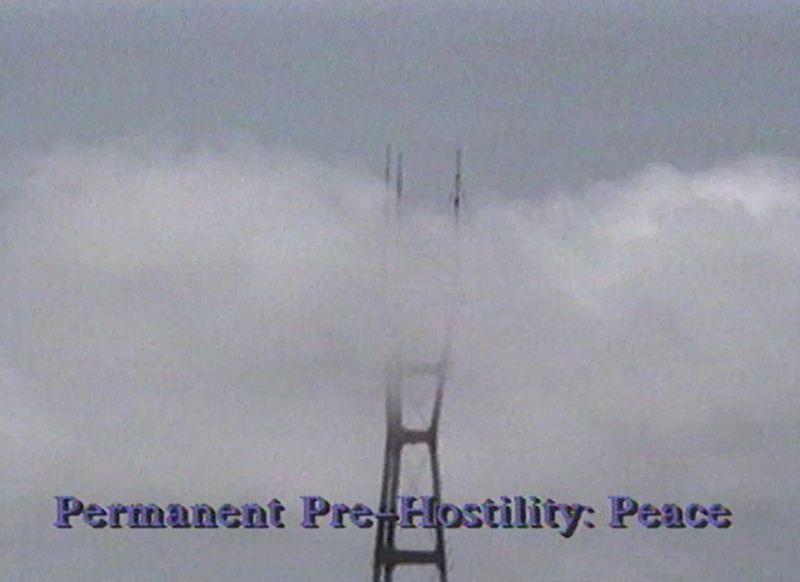
Finley’s work is not a spoken text with illustrations. It is rather an attempt to bundle an analysis in three interconnected transmission modes—an audio track (divided into musical score and spoken word), moving images, and finally on-screen text. Two types of text appear in the subtitle track. One layer reinforces the audio by simply repeating passages of what is spoken, but the other deciphers the coded language being spoken by adding keywords. Very soon the viewer understands the inherent absurdity: we learn that “involuntary conversion,” a term originated in real estate transactions, stands for a market crash, that “career alternative enhancement program” means lay-offs, and that “serving the target” simply means to kill. From a military combat perspective, apparently, peace is nothing but “pre-hostility.”
In its visual layer, Involuntary Conversion is filled with dark, dystopian city imagery. Apart from the recurring spy planes, another strong allegorical image that Finley repeats throughout the nine-and-a-half minutes depicts a Caterpillar on an urban demolition site at night. In conjunction with the text layers, a wide chain of associations is produced here—financial extraction, elimination, executive force, surveillance, and the lurking powers of the hidden deep state.
It is the friction between the semantic interplay of what is shown, what is spoken, and what is written in the subtitles that turns the language into something codified or foreign, language that requires translation, even for the English native speaker.
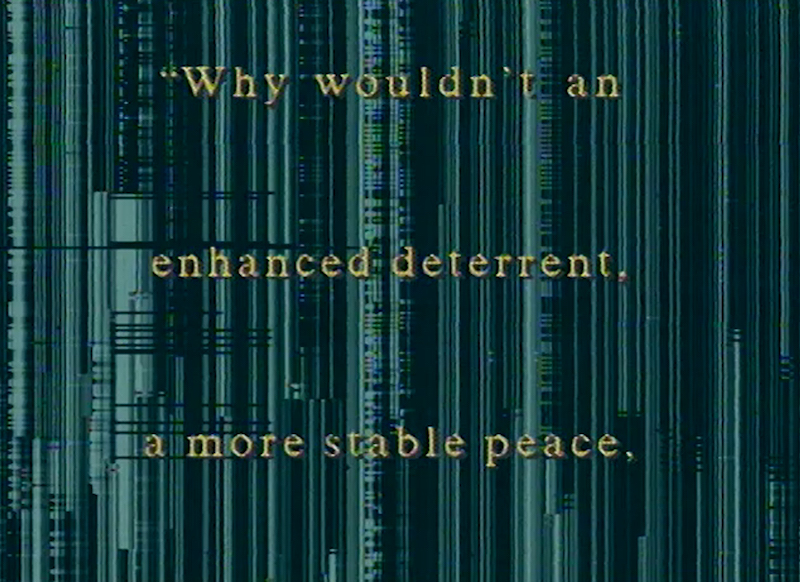
IV.
“Why wouldn’t an enhanced deterrent, a more stable peace, a better prospect to denying the ones who enter conflict in the first place to have a reduction of offensive systems and an introduction to defensive capability. I believe that is the route this country will eventually go.”
This is a quote from Dan Quayle that became, for critics, an apex in the use of distorted political jargon. Finley includes this quote—spoken and written—at the end of the video, showing an absolute failure of Doublespeak, as any construction of meaning (hidden or obvious) is destined to entirely collapse here. Quayle, the then-Indiana senator campaigning as vice president for George Bush’s presidential campaign, gave a speech at a luncheon at the City Club of Chicago in early September 1988. Apparently, Quayle threw away his well-prepared script as he encountered the sudden urge to speak freely, and came up with this.
Theorist and translator Keith Sanborn diagnoses that behind Quayle’s derailing was the attempt to identify a paradox in his own offense/defense talk, with the clever intention to then resolve it, but instead creating more contradictions that became impossible to resolve. In other words, Quayle, as Sanborn explains, “wants to say ‘defense’ as it is a more stable alternative than ‘offense’ but can’t quite bring himself to do it, because an offensive strategy is more macho. [...] So he is torn in two directions, and his sentence structure—weak to begin with— and rhetoric crumbles under the stress.” 5
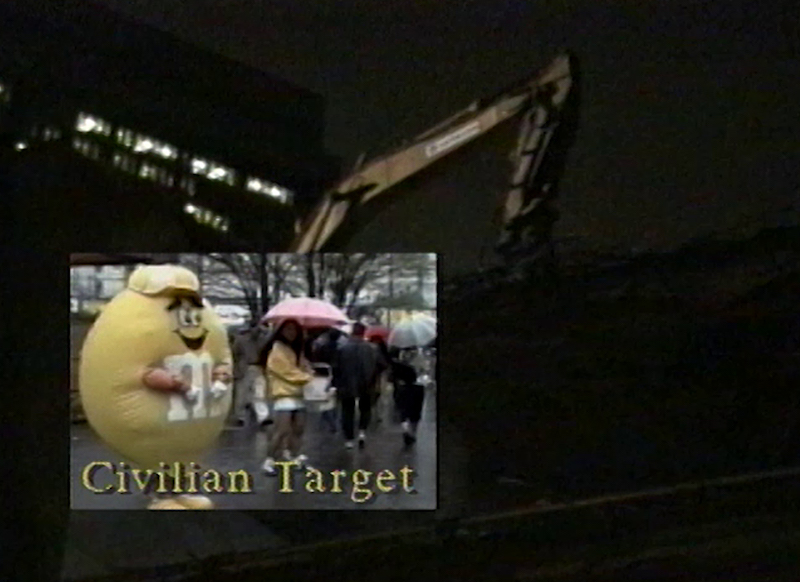
The event, a complete crash of Doublespeak, revealed the internalized structure of phrases that a politician typically memorizes and combines in patterns of phrase blocks. In her collage editing, I would speculate, Finley mirrored this very strategy. A closer look at the image successions of her two key images reveal “sentences” that either start or end with the spy plane or the destructive Caterpillar at night. Their creative exchangeability becomes apparent when placed into different contexts: Finley pairs them variously with dystopian urban landscapes, air pollution, police state, hostile places, and a Chris Marker-like observation of futurist Japanese Megacity culture of the 1980s.
As the semantic openness of individual image components in film language allows an outcome with multiple interpretations, the alteration of political speech patterns might produce similar multiple readings. But the latter leads to devastating consequences. Particular segments of a sentence have the ability to cancel each other out, assuring a complete meaningless chaos of fragments as seen in Quayle’s case. The absurdity of how internalized phrases can be threaded together creates a strong parallel to artificial language: for instance, machine-generated speech that may have a level of sophistication that respects grammar in a way Chomsky’s aforementioned nonsense sentence does. They produce a mix of equally meaningful and meaningless statements.
Recent developments in machine learning, specifically the developments of Recurrent Neural Networks (RNN), have created puzzling political speeches written by a program that learned from millions of sentences of a politician. The software developer Samim made use of such an RNN that was fine-tuned for so-called character-level language models. Samim made headlines after publishing what he named an “Obama RNN,” developed from 730895 words of available Obama speeches. Once a library is established, the program takes an arbitrary text file as input and learns to predict the next sentences in sequence.
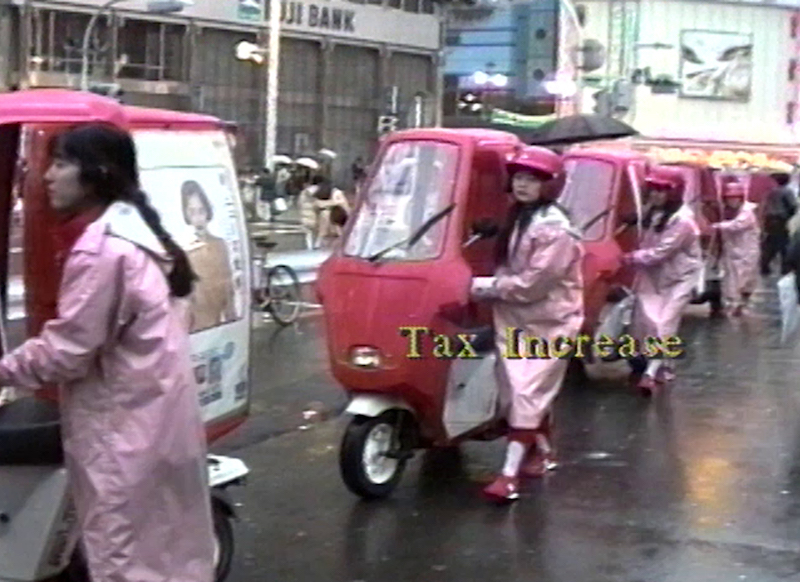
This is probably the most fundamental difference between human gibberish and machine-created gibberish: The RNN is given thematic input and therefore creates a text following an underlying telos. The program not only imitates the choice of vocabulary and rhetoric of the analyzed source, it develops the ability to write towards something. The outcome becomes frightening close to the derailed speech patterns uttered by Quayle and similar candidates (from Sarah Palin to Boris Johnson).
This provokes the question: which one influenced which? Do those algorithms also assimilate human errors, and/or do today’s public speakers mimic machine-learned speech patterns?
Regardless of whether they are artificially produced or caused by human error (even as a deliberate strategy), sentences without clear meaning are open to interpretation. Here lies the true danger, as the current sentence-by-sentence self-contradicting diarrhea language of Donald Trump has made evident. In this context, it is clear that political speech itself no longer has intrinsic meaning; it has become a mere empty placeholder. The potential agency of this proto-language is only activated when subject to appropriation—only when the background operators step in and channel these contradicting sentences in the desired direction.
On the front end, we have no choice but to face this destruction of communication and the emergence of (the hysterically over-used term) post-truth. Factual rebuttals and immediate criticism have been removed to such an extent that the sharp and blunt lie stands on its own, now appearing permanently in US media and government rhetoric—and reproduced globally. Compared with the climax of uncontrolled Doublespeak stunts in the late Cold War era, it could be considered the outcome of the military “shock and awe” tactic, a doctrine developed under Bush Senior’s administration, before the first Iraq invasion.

There was a long evolution from obscurity to shotgun approach, and this inspired Jeanne Finley and her artistic collaborator John Muse to respond to this current development and dissect, once again, the state of political speech in the case of a Trump comparison with the unabashed, laconic speech rhetoric of the fictive advertising Mad Man Don Draper in their video Book Report” (2017).
In times of political urgency, it’s necessary to actively develop counter measures. If populist post-truth strategies have produced a Triplespeak, (including the post-interpretation) we have to strip down this economy of misinformation, returning to Singlespeak. We must find a dutiful way to actively deconstruct false political messages, when and wherever possible.
In 2014, Dutch artist Helmut Smits introduced a simple machine to turn Coca-Cola back into drinking water. It was a commentary on Coca-Cola’s imperialism, which sells unhealthy sugar drinks in impoverished regions that don’t even possess water access. But it was also a potentially useful technology. In the same vein, it is now on us to help distil gobbledygook into clear messages whose dangerous content is universally comprehendible.
- 1. Sean Cubitt, Time Shift – On Video Culture (1991). Cubitt was not the first to romantically associate this Bergsonian term with video technology, but was the first to profoundly dissect TV culture, complicating MacLuhan’s media-is-the-message paradigm. He added a “constant fading” to the "constant becoming,” which seems especially crucial given this medium’s spatiotemporal characteristics.
- 2. William Lutz, Doublespeak: From "Revenue Enhancement" to "Terminal Living": How Government, Business, Advertisers, and Others Use Language to Deceive You (1989).
- 3. “Defense Dept. Wins Doublespeak Award for War Terms That Bombed,” Los Angeles Times, Nov. 23, 1991.
- 4. Avital Ronell, Finitude's Score: Essays for the End of the Millennium (University of Illinois Press, 1994), 307.
- 5. Keith Sanborn in private email interview.
“Why wouldn’t an enhanced deterrent, a more stable peace, a better prospect to denying the ones who enter conflict in the first place to have a reduction of offensive systems and an introduction to defensive capability. I believe that is the route this country will eventually go.”
This is a quote from Dan Quayle that became, for critics, an apex in the use of distorted political jargon. Finley includes this quote—spoken and written—at the end of the video, showing an absolute failure of Doublespeak, as any construction of meaning (hidden or obvious) is destined to entirely collapse here. Quayle, the then-Indiana senator campaigning as vice president for George Bush’s presidential campaign, gave a speech at a luncheon at the City Club of Chicago in early September 1988. Apparently, Quayle threw away his well-prepared script as he encountered the sudden urge to speak freely, and came up with this.
Theorist and translator Keith Sanborn diagnoses that behind Quayle’s derailing was the attempt to identify a paradox in his own offense/defense talk, with the clever intention to then resolve it, but instead creating more contradictions that became impossible to resolve. In other words, Quayle, as Sanborn explains, “wants to say ‘defense’ as it is a more stable alternative than ‘offense’ but can’t quite bring himself to do it, because an offensive strategy is more macho. [...] So he is torn in two directions, and his sentence structure—weak to begin with— and rhetoric crumbles under the stress.” 5

The event, a complete crash of Doublespeak, revealed the internalized structure of phrases that a politician typically memorizes and combines in patterns of phrase blocks. In her collage editing, I would speculate, Finley mirrored this very strategy. A closer look at the image successions of her two key images reveal “sentences” that either start or end with the spy plane or the destructive Caterpillar at night. Their creative exchangeability becomes apparent when placed into different contexts: Finley pairs them variously with dystopian urban landscapes, air pollution, police state, hostile places, and a Chris Marker-like observation of futurist Japanese Megacity culture of the 1980s.
As the semantic openness of individual image components in film language allows an outcome with multiple interpretations, the alteration of political speech patterns might produce similar multiple readings. But the latter leads to devastating consequences. Particular segments of a sentence have the ability to cancel each other out, assuring a complete meaningless chaos of fragments as seen in Quayle’s case. The absurdity of how internalized phrases can be threaded together creates a strong parallel to artificial language: for instance, machine-generated speech that may have a level of sophistication that respects grammar in a way Chomsky’s aforementioned nonsense sentence does. They produce a mix of equally meaningful and meaningless statements.
Recent developments in machine learning, specifically the developments of Recurrent Neural Networks (RNN), have created puzzling political speeches written by a program that learned from millions of sentences of a politician. The software developer Samim made use of such an RNN that was fine-tuned for so-called character-level language models. Samim made headlines after publishing what he named an “Obama RNN,” developed from 730895 words of available Obama speeches. Once a library is established, the program takes an arbitrary text file as input and learns to predict the next sentences in sequence.

This is probably the most fundamental difference between human gibberish and machine-created gibberish: The RNN is given thematic input and therefore creates a text following an underlying telos. The program not only imitates the choice of vocabulary and rhetoric of the analyzed source, it develops the ability to write towards something. The outcome becomes frightening close to the derailed speech patterns uttered by Quayle and similar candidates (from Sarah Palin to Boris Johnson).
This provokes the question: which one influenced which? Do those algorithms also assimilate human errors, and/or do today’s public speakers mimic machine-learned speech patterns?
Regardless of whether they are artificially produced or caused by human error (even as a deliberate strategy), sentences without clear meaning are open to interpretation. Here lies the true danger, as the current sentence-by-sentence self-contradicting diarrhea language of Donald Trump has made evident. In this context, it is clear that political speech itself no longer has intrinsic meaning; it has become a mere empty placeholder. The potential agency of this proto-language is only activated when subject to appropriation—only when the background operators step in and channel these contradicting sentences in the desired direction.
On the front end, we have no choice but to face this destruction of communication and the emergence of (the hysterically over-used term) post-truth. Factual rebuttals and immediate criticism have been removed to such an extent that the sharp and blunt lie stands on its own, now appearing permanently in US media and government rhetoric—and reproduced globally. Compared with the climax of uncontrolled Doublespeak stunts in the late Cold War era, it could be considered the outcome of the military “shock and awe” tactic, a doctrine developed under Bush Senior’s administration, before the first Iraq invasion.

There was a long evolution from obscurity to shotgun approach, and this inspired Jeanne Finley and her artistic collaborator John Muse to respond to this current development and dissect, once again, the state of political speech in the case of a Trump comparison with the unabashed, laconic speech rhetoric of the fictive advertising Mad Man Don Draper in their video Book Report” (2017).
In times of political urgency, it’s necessary to actively develop counter measures. If populist post-truth strategies have produced a Triplespeak, (including the post-interpretation) we have to strip down this economy of misinformation, returning to Singlespeak. We must find a dutiful way to actively deconstruct false political messages, when and wherever possible.
In 2014, Dutch artist Helmut Smits introduced a simple machine to turn Coca-Cola back into drinking water. It was a commentary on Coca-Cola’s imperialism, which sells unhealthy sugar drinks in impoverished regions that don’t even possess water access. But it was also a potentially useful technology. In the same vein, it is now on us to help distil gobbledygook into clear messages whose dangerous content is universally comprehendible.
- 1. Sean Cubitt, Time Shift – On Video Culture (1991). Cubitt was not the first to romantically associate this Bergsonian term with video technology, but was the first to profoundly dissect TV culture, complicating MacLuhan’s media-is-the-message paradigm. He added a “constant fading” to the "constant becoming,” which seems especially crucial given this medium’s spatiotemporal characteristics.
- 2. William Lutz, Doublespeak: From "Revenue Enhancement" to "Terminal Living": How Government, Business, Advertisers, and Others Use Language to Deceive You (1989).
- 3. “Defense Dept. Wins Doublespeak Award for War Terms That Bombed,” Los Angeles Times, Nov. 23, 1991.
- 4. Avital Ronell, Finitude's Score: Essays for the End of the Millennium (University of Illinois Press, 1994), 307.
- 5. Keith Sanborn in private email interview.


